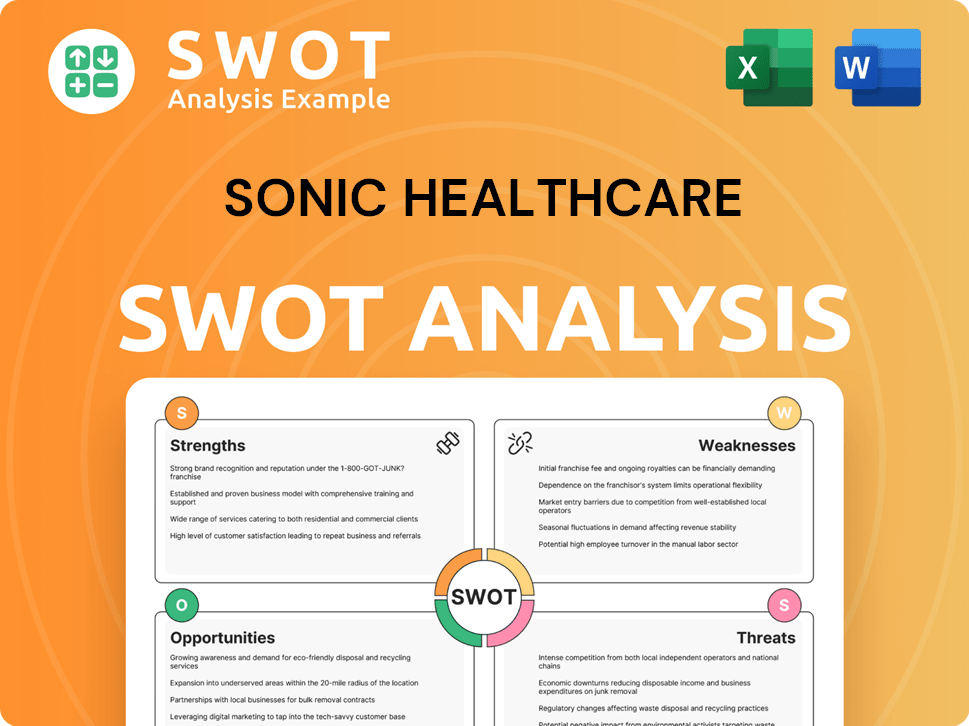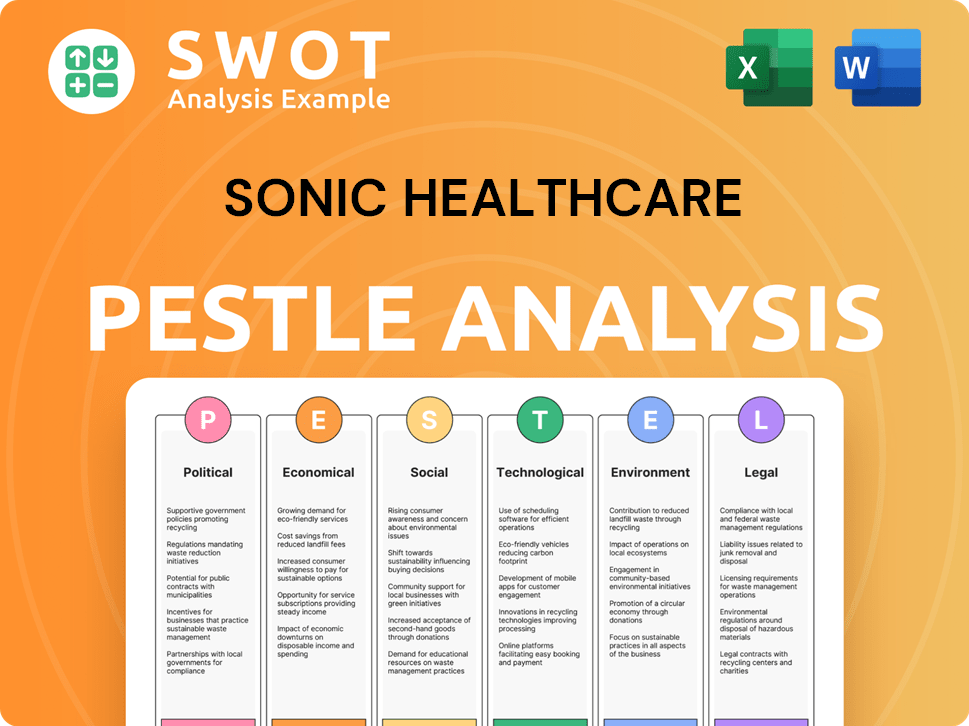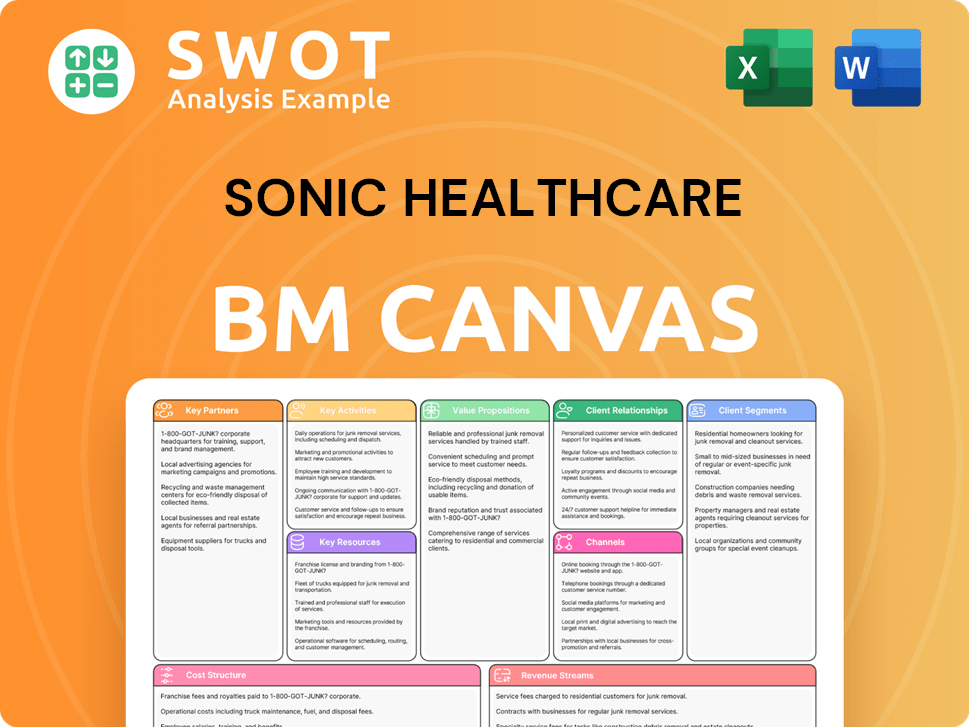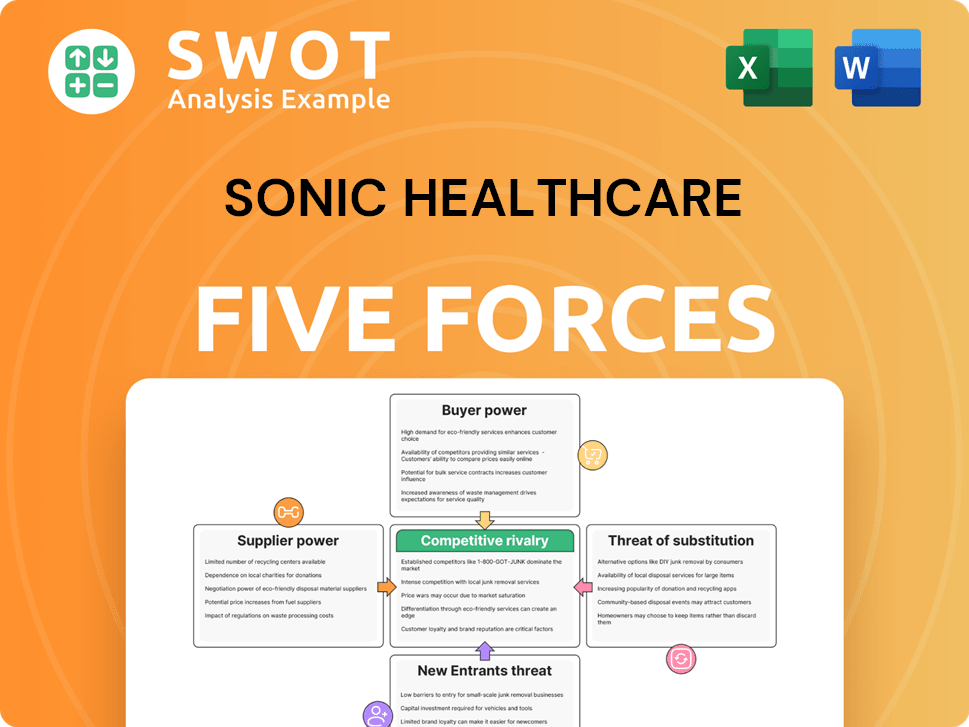Sonic Healthcare Bundle
How Does Sonic Healthcare Thrive in the Healthcare Industry?
Sonic Healthcare, a global force in medical diagnostics, reported impressive financials in 2024, despite a shift away from pandemic-driven revenue. With a robust revenue of A$9.0 billion and strategic market positioning, the company showcases remarkable resilience. Headquartered in Sydney, Australia, and operating worldwide, Sonic Healthcare has become a key player in the healthcare industry.

This deep dive into the Sonic Healthcare SWOT Analysis will uncover the intricacies of the Sonic Healthcare company, exploring its core operations, revenue streams, and strategic initiatives. Understanding the Sonic Healthcare business model is essential for investors and industry professionals seeking to navigate the complexities of the medical diagnostics market. We'll examine how Sonic Healthcare's global presence and diverse services, including pathology services, contribute to its sustained success and future growth potential, providing valuable insights into this healthcare industry leader.
What Are the Key Operations Driving Sonic Healthcare’s Success?
The core of the Sonic Healthcare company revolves around delivering medical diagnostic services. This encompasses laboratory medicine (pathology), radiology, and primary care medical services. The company's value proposition lies in providing a comprehensive and integrated approach to healthcare diagnostics, serving a wide array of customers including general practitioners, specialists, hospitals, and community health services.
Sonic Healthcare's operational model is built on a 'Federated Model,' allowing individual medical practices and geographies to operate autonomously within a synergistic network. This structure fosters a unique culture where clinicians see themselves as part of specialist medical practices rather than just businesses, which has been a key factor in the company's successful acquisitions. This approach enables Sonic Healthcare to offer tailored services that meet the specific needs of local medical communities.
Sonic Healthcare generates value through its extensive network of laboratories and imaging centers across multiple countries, facilitating a wide range of diagnostic tests. The company's focus on innovation and operational efficiency, combined with its federated structure, allows it to maintain a strong market position. For more insights into their approach, you can explore the Marketing Strategy of Sonic Healthcare.
Sonic Healthcare's services include pathology, radiology, and primary care. Pathology services involve analyzing samples to diagnose diseases. Radiology services use imaging techniques like X-rays and MRIs. Primary care offers general medical services.
The customer base includes general practitioners, specialists, hospitals, and community health services. These entities rely on Sonic Healthcare for accurate and efficient diagnostic services to aid in patient care. This broad customer base supports the company's revenue streams.
Sonic Healthcare operates under a 'Federated Model,' allowing autonomy within a synergistic network. This model fosters a unique employee culture and supports acquisitions. It also enables the company to adapt to local market needs.
Competitive advantages include a 'Medical Leadership' culture and centralized executive support. High standards of professional excellence, strong relationships with medical professionals, and operational efficiency are key differentiators. Investments in digital pathology also contribute to its edge.
In recent financial reports, Sonic Healthcare has demonstrated consistent revenue growth, reflecting its strong market position. For instance, the company's revenue in the fiscal year 2024 reached approximately $9.5 billion. They have also increased their investments in digital pathology and AI to improve efficiency and quality.
- Revenue Growth: The company has shown a steady increase in revenue, indicating strong performance in the healthcare industry.
- Global Presence: Sonic Healthcare operates a vast network of laboratories and imaging centers across multiple countries, expanding its global reach.
- Strategic Investments: Significant investments in digital pathology and IT infrastructure are aimed at improving efficiency and quality.
- Market Position: The company maintains a strong market position through its focus on innovation and operational efficiency.
Sonic Healthcare SWOT Analysis
- Complete SWOT Breakdown
- Fully Customizable
- Editable in Excel & Word
- Professional Formatting
- Investor-Ready Format

How Does Sonic Healthcare Make Money?
The Sonic Healthcare company primarily generates revenue through medical diagnostic services. Laboratory medicine/pathology is the major contributor, accounting for approximately 85% of the group's revenue, while radiology services make up about 10%. The remaining revenue comes from primary care medical centers and corporate medical services, mainly in Australia.
For the half-year that ended December 31, 2024, the Sonic Healthcare business model showed strong financial performance, with revenue reaching AUD 4.67 billion, an 8.4% increase year-on-year. This growth was largely driven by robust organic revenue growth of 6.1%, particularly in the Australian, German, and UK laboratory businesses. This demonstrates the company's strong position in the healthcare industry.
In the 2024 financial year, Sonic Healthcare achieved a total revenue of A$9.0 billion. The company's base business revenue, excluding COVID-related income, grew by 16%, including 6% organic growth. This highlights the company's ability to expand its core diagnostic services independently of pandemic-driven demand.
The company's monetization strategies are largely based on a fee-for-service model for its diagnostic tests and services. Sonic Healthcare employs a 'roll-up' strategy, acquiring fragmented markets in Australia, Europe, and the USA. This strategy allows it to build scale and infrastructure, leading to synergies and improved margins. The company also benefits from increasing demand for medical diagnostics due to growing and aging populations.
- Consolidating markets allows for centralized testing and leverages group purchasing power, boosting profitability.
- Investments in artificial intelligence (AI) in pathology and radiology are expected to improve efficiency and capacity.
- Geographically, about 40% of group revenue comes from Australia and New Zealand, 25% from the US, and 35% from Europe.
- Strategic expansion into advanced genetics and specialty pathology positions the company to capitalize on personalized medicine. For more information about the company's position in the market, you can explore the Competitors Landscape of Sonic Healthcare.
Sonic Healthcare PESTLE Analysis
- Covers All 6 PESTLE Categories
- No Research Needed – Save Hours of Work
- Built by Experts, Trusted by Consultants
- Instant Download, Ready to Use
- 100% Editable, Fully Customizable

Which Strategic Decisions Have Shaped Sonic Healthcare’s Business Model?
The journey of the Sonic Healthcare company, a global leader in medical diagnostics, is marked by significant growth and strategic initiatives. Since its listing on the Australian Securities Exchange in April 1987, the company has expanded substantially through a combination of organic growth and strategic acquisitions. Its focus on integrating new technologies, particularly in digital pathology and AI, demonstrates its commitment to innovation and efficiency within the healthcare industry.
Sonic Healthcare's strategic moves include substantial investments in digital pathology and associated IT infrastructure, anticipating that Artificial Intelligence (AI) will deliver 'step changes in efficiency, quality, and capacity' in pathology and radiology. The acquisition of PathologyWatch (USA) in January 2024, a business focused on digital pathology and AI technology, is a clear example of this strategy. The company has also addressed operational challenges, such as inflationary pressures and currency exchange headwinds, through cost control measures and margin expansion initiatives.
The company's competitive edge stems from its commitment to high-quality diagnostic services, its skilled workforce, and its efficient supply chain. Moreover, Sonic Healthcare's 'Medical Leadership' model, which empowers local management teams, is a unique cultural and operational advantage. This model fosters strong relationships with referring doctors, contributing to market share gains and consistent organic growth. Its international scale and diversified geographic presence provide a significant competitive edge, allowing it to leverage existing infrastructure and realize synergies.
Listing on the Australian Securities Exchange in April 1987 marked a significant milestone. Strategic acquisitions and organic growth have been key drivers. The acquisition of PathologyWatch (USA) in January 2024, a digital pathology and AI technology company, is a recent strategic move.
Focus on integrating new technologies, particularly AI in pathology and radiology. Investments in digital pathology and associated IT infrastructure are substantial. Cost control measures and margin expansion initiatives to address operational challenges.
Strong brand reputation built on high-quality diagnostic services. A highly skilled workforce, including 1,600 pathologists and radiologists. Efficient supply chain and 'Medical Leadership' model that empowers local management teams and fosters strong relationships with referring doctors.
While FY2024 saw challenges from inflationary pressures and currency exchange headwinds, the company responded with cost control. The new revenue collection system in the US is expected to deliver financial benefits. Sonic Healthcare's strong balance sheet supports further acquisitions.
Sonic Healthcare's competitive advantages are multifaceted, including a strong brand reputation and a skilled workforce. The company's 'Medical Leadership' model fosters strong relationships with referring doctors, leading to market share gains. Its international scale and diversified geographic presence provide a significant competitive edge, allowing it to leverage existing infrastructure and realize synergies. Read more about the Growth Strategy of Sonic Healthcare.
- Strong brand reputation and commitment to quality.
- Highly skilled workforce of pathologists and radiologists.
- Efficient supply chain and operational excellence.
- 'Medical Leadership' model fostering local empowerment.
Sonic Healthcare Business Model Canvas
- Complete 9-Block Business Model Canvas
- Effortlessly Communicate Your Business Strategy
- Investor-Ready BMC Format
- 100% Editable and Customizable
- Clear and Structured Layout

How Is Sonic Healthcare Positioning Itself for Continued Success?
The following outlines the industry position, risks, and future outlook for the healthcare company, a prominent player in the global medical diagnostics market. This analysis considers the company's current standing, potential challenges, and growth prospects, providing a comprehensive view for stakeholders.
The company's strategic decisions and operational performance within the healthcare industry are key factors influencing its trajectory. Understanding these elements is crucial for assessing its overall value and future potential, especially in a dynamic market environment.
The company holds a strong position as a leading healthcare provider globally, operating in seven countries. It is the third-largest medical diagnostics company worldwide. The company is the largest private pathology operator in Australia, Germany, Switzerland, and the UK, showcasing a significant market presence.
Key risks include changes in taxation legislation, currency exchange rate fluctuations, and climate-related risks. Regulatory changes, such as potential fee reductions in the USA from January 1, 2025, and cuts to national fee schedules, could impact profitability. New competitors and technological disruption also pose ongoing challenges.
The company has a positive outlook, expecting EBITDA for FY2025 to be in the range of A$1.70 billion to A$1.75 billion on a constant currency basis, representing approximately 10% growth on FY2024. This growth will be driven by organic revenue growth, cost reduction, and acquisitions.
Strategic initiatives include further acquisitions in fragmented markets like the USA and Germany. The upcoming acquisition of LADR Laboratory Group in Germany is projected to contribute over A$80 million annually to EBITDA. Investments in digital pathology and AI technology are also planned.
The company's success hinges on several factors, including its ability to navigate regulatory changes and maintain operational efficiency. The company's 'Medical Leadership' culture and its focus on acquisitions are key to its competitive differentiation. For investors considering the target market of Sonic Healthcare, understanding these elements is crucial.
- The company's strong market presence allows it to leverage infrastructure and realize synergies for earnings growth.
- The company's reliance on achieving meaningful EBITDA margin expansion in the medium term is critical.
- Investments in digital pathology and AI technology will drive efficiencies and enhance quality.
- The company aims to sustain and expand its profitability through continued organic growth, strategic acquisitions, and technological advancements.
Sonic Healthcare Porter's Five Forces Analysis
- Covers All 5 Competitive Forces in Detail
- Structured for Consultants, Students, and Founders
- 100% Editable in Microsoft Word & Excel
- Instant Digital Download – Use Immediately
- Compatible with Mac & PC – Fully Unlocked

Related Blogs
- What are Mission Vision & Core Values of Sonic Healthcare Company?
- What is Competitive Landscape of Sonic Healthcare Company?
- What is Growth Strategy and Future Prospects of Sonic Healthcare Company?
- What is Sales and Marketing Strategy of Sonic Healthcare Company?
- What is Brief History of Sonic Healthcare Company?
- Who Owns Sonic Healthcare Company?
- What is Customer Demographics and Target Market of Sonic Healthcare Company?
Disclaimer
All information, articles, and product details provided on this website are for general informational and educational purposes only. We do not claim any ownership over, nor do we intend to infringe upon, any trademarks, copyrights, logos, brand names, or other intellectual property mentioned or depicted on this site. Such intellectual property remains the property of its respective owners, and any references here are made solely for identification or informational purposes, without implying any affiliation, endorsement, or partnership.
We make no representations or warranties, express or implied, regarding the accuracy, completeness, or suitability of any content or products presented. Nothing on this website should be construed as legal, tax, investment, financial, medical, or other professional advice. In addition, no part of this site—including articles or product references—constitutes a solicitation, recommendation, endorsement, advertisement, or offer to buy or sell any securities, franchises, or other financial instruments, particularly in jurisdictions where such activity would be unlawful.
All content is of a general nature and may not address the specific circumstances of any individual or entity. It is not a substitute for professional advice or services. Any actions you take based on the information provided here are strictly at your own risk. You accept full responsibility for any decisions or outcomes arising from your use of this website and agree to release us from any liability in connection with your use of, or reliance upon, the content or products found herein.